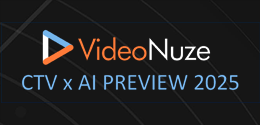-
Inside the Stream Podcast: Interview with Innovid’s CEO and Co-Founder Zvika Netter on CTV Dynamics and SPAC
Welcome to this week’s edition of Inside the Stream, the podcast where nScreenMedia’s Chief Analyst Colin Dixon and I take listeners inside the world of streaming video.
This week we’re pleased to have Zvika Netter, CEO and Co-Founder of Innovid, as our guest. Innovid has been in video advertising for 14 years, evolving from an early player in interactive ads to become the leading delivery and measurement platform for brands and agencies. Importantly, as Zvika explains, Innovid has held fast over the years to being independent - not involved with any media buying or selling, which he views as a clear differentiator.
Late last week Innovid achieved a major milestone, by filing to go public via a SPAC. Zvika explains the decision process, and his points are a great counterpart to our conversation last week with JW Player’s Dave Otten, who also considered a SPAC, but decided instead to raise a large private round.
But the bulk of our time with Zvika is spent drilling into CTV, what’s driving the business, the key challenges, how they’re being addressed, what’s ahead, and of course, what role Innovid is playing. For anyone who wants a really deep dive into CTV, the interview is an intimate window into the CTV ad buyers’ perspective and how this is influencing the future shape of the industry.
(Note, Colin and I will be taking a break next week for the holiday, so we’ll be back in a couple of weeks)
Listen to the podcast (32 minutes, 17 seconds)
Browse all previous podcasts
Subscribe to Inside the Stream
Apple Podcasts Google Podcasts Spotify Amazon Music RSSCategories: Advertising, Deals & Financings, Podcasts
Topics: Innovid
-
4 TV Buying Trends to Watch in the Back Half of 2021 (and Beyond)
Thursday, July 1, 2021, 10:15 AM ETPosted by:TV and entertainment viewing patterns changed dramatically in 2020, accelerating numerous evolutions already afoot in TV targeting, reporting, data, measurement and more. What’s around the bend in media buying? Here are a few key areas of industry focus to keep on your radar.
More Is More in Streaming
The appetite for streaming content has skyrocketed and shows no signs of slowing down. Global viewing grew 44 percent during the last three months of 2020, according to research firm Convivia, which tracks 500 million unique viewers and 180 billion streams annually. In fact, within this streaming surge, ad-based video on demand (VOD) is projected to experience 22 percent compound annual growth and become a $20 billion segment by 2024, according to the VAB. If your TV ad strategy hasn’t pivoted to align with this surge, it’s in urgent need of a refresh. It’s also worth noting that this surge in streaming is on top of existing cable viewership, not in place of it.Categories: Advertising
Topics: New York Interconnect
-
Research: Sports Viewership is Migrating to CTV and Streaming
Sports has long been considered the “firewall” for pay-TV subscriptions, with marquee events carried by must-have broadcast and cable TV networks. But new research from The Trade Desk shows that sports viewership is increasing migrating away from linear TV and toward connected TVs and streaming. In its fourth “Future of TV” report, The Trade Desk found that 57% of Americans watch sports at least once per week, and that of these viewers, 44% are watching outside of linear TV. The number rises to 65% for 18-34 year olds.
The viewership levels underscore the degree to which top tier sports have begun “leaking” out of the traditional broadcast/cable TV world and into streaming, and also the existential threat to pay-TV if a big chunk of sports eventually moves into the streaming realm. Importantly, The Trade Desk found that just 19% of TV viewers are returning to their pre-pandemic sports viewing mode, with 44% of fans saying they’re watching sports outside of linear TV (65% for 18-34 year olds).Categories: Sports
Topics: The Trade Desk
-
YouTube TV’s New 4K Plus Brings Valuable Offline Viewing Feature
Yesterday YouTube TV announced a new add-on feature called 4K Plus, which includes the ability to download recorded DVR programming to mobile devices for subsequent offline viewing. Diehard VideoNuze readers know that since October, 2012, when I wrote “TiVo Stream’s Downloading Feature is a Bona Fide Killer App” I have been an unabashed proponent of downloading/offline viewing.
As I wrote then, downloading offers multiple benefits to users, and to the services offering the feature. Though mobile connectivity is far better today than 9 years ago, there are still plenty of times when a cost-effective, high-quality Internet connection isn’t available (e.g. planes, trains, rural driving, etc.). At those moments, if you want to watch video, you’re out of luck. Downloading enables viewers to be untethered from the Internet and yet still have access to their DVR library.Categories: Downloads, DVR, Skinny Bundles
Topics: YouTube TV
-
Research Shows Strong Interest in Ad-Supported Streaming
Last Friday Hub Research published interesting survey results about consumers’ willingness/desire to watch ad-supported streaming services, especially if it means saving money compared to more expensive ad-free alternatives. No surprise to anyone who’s been playing close attention to the evolving SVOD/AVOD landscape, the research showed strong interest in ad-supported streaming. For me it was further validation of the Connected TV flywheel that I have described that is only going to accelerate adoption as consumption of ad-supported video both deepens and broadens.
Categories: Advertising
Topics: Hub Research
-
Inside the Stream Podcast: Interview with JW Player’s CEO and Co-Founder Dave Otten
Welcome to this week’s edition of Inside the Stream, the podcast where nScreenMedia’s Chief Analyst Colin Dixon and I take listeners inside the world of streaming video.
Yesterday, JW Player announced a $100 million financing from LLR Partners. On this week’s podcast, we’re privileged to have JW’s CEO and co-founder Dave Otten joins us as a guest for a wide-ranging discussion.
Dave provides an update on JW and its competitive differentiators including its ease of deployment and focus on the “monetization layer” (i.e. helping its publishing partners drive revenue from their video assets). Importantly, Dave dives deeply into JW’s data strategy, and how being the video player for such a massive range of publishers gives it critical insights into usage and provides contextual data that can then be leveraged for improved monetization. Dave also gets into why he’s bullish on live, subscription-based models, connected TV, where the industry is heading and much more.
Dave explains the new financing round and how JW decided to go this route instead of doing a SPAC/IPO which are both very popular (just yesterday Innovid and Buzzfeed announced SPAC deals, here and here).
It’s a fascinating interview, which I highly recommend for anyone interested especially in the role of data, and what’s ahead for the video industry.
Listen to the podcast (31 minutes, 8 seconds)
Browse all previous podcasts
Subscribe to Inside the Stream
Apple Podcasts Google Podcasts Spotify Amazon Music RSS
Note I’ll continue to publish Inside the Stream in the prior feedCategories: Deals & Financings, Podcasts
-
If the FTC Challenges Amazon-MGM Deal It is Unlikely to Succeed
The Wall Street Journal reported yesterday that the FTC will be the agency to review Amazon’s acquisition of MGM. A review was expected, either by the Justice Department or the FTC. The plot thickener here is that the brand new FTC chair is Lina Khan, a law professor and journalist who was confirmed by the Senate last week in a bipartisan 69-29 vote. Importantly Khan is a critic of Amazon and Big Tech, having written a widely circulated article, “Amazon’s Antitrust Paradox,” in 2017.
The article argues, in a nutshell, that the current approach to antitrust, which is focused on “consumer welfare,” is insufficient to oversee platform-based businesses like Amazon which can use predatory pricing for their overall competitive benefit. Rather, Khan believes that antitrust oversight needs to be driven by gauging the concentration of market structures and competitive process, which she writes is a more traditional approach. Khan shares five factors for how to evaluate the competitive process.Categories: Deals & Financings, Studios, SVOD
-
Nielsen’s New Viewership Pie Chart is Valuable, But Keep an Eye on Younger Viewers’ Patterns
Late last week Nielsen released The Gauge, a pie chart representation of the total time Americans spent watching cable TV, broadcast TV and streaming services. It is a valuable new way of assessing TV vs. streaming consumption, but it doesn’t show a complete picture of all that’s happening, especially among younger viewers.
The chart showed that despite all the attention paid to streaming services, cable and broadcast networks still received 39% and 25% of viewing time respectively. In particular, for all the ink that’s been spilled covering Disney+’s meteoric growth since launch in late 2019, it still accounts for just 1% of viewership. And for all the billions of dollars Netflix has spent on original content since the “House of Cards” launch over eight years ago, it still accounts for just 6% of viewing time.Topics: Nielsen



